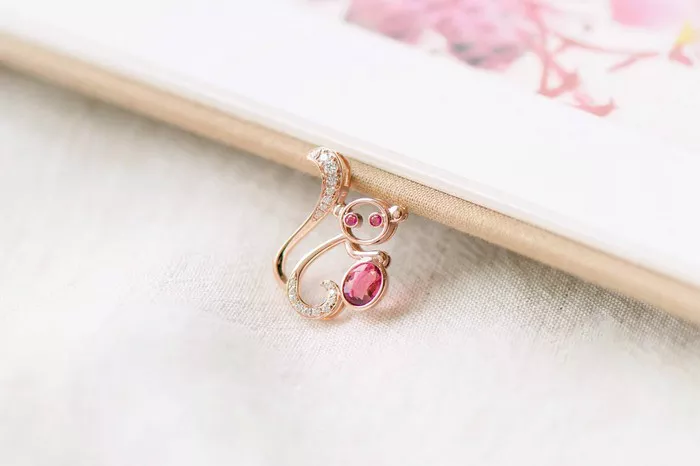Pink tourmaline, also known as Pink Tourmaline, is a precious gemstone renowned for its romantic hues and delicate beauty. It holds a special place among gem enthusiasts and collectors due to its unique charm and symbolic meanings. While the exact date of its discovery is not definitively recorded in history, the journey of pink tourmaline from being an unknown mineral to a cherished gemstone is filled with fascinating stories and historical significance. This article aims to provide a detailed introduction to pink tourmaline, including its discovery, characteristics, and cultural significance, in a logical and easy-to-understand manner.
The Origins and Characteristics of Pink Tourmaline
Tourmaline is a complex boron silicate mineral that belongs to the group of gemstones known as电气石 (Electric Stones) due to their pyroelectric properties. This means they can generate electricity when heated or subjected to pressure. Pink tourmaline, as a variety of tourmaline, gets its characteristic pink color from the presence of lithium (Lithium) and other trace elements within its crystalline structure.
The color range of pink tourmaline is vast, varying from pale pink to vivid peach and, in rare cases, deep red similar to rubies. This variety in color is one of the reasons for its popularity among gem lovers. The gemstone’s hardness ranges from 7 to 7.5 on the Mohs scale, making it durable enough for everyday wear in jewelry.
Historical Context and Discovery
Although the exact date of the discovery of pink tourmaline is unclear, the history of tourmaline as a gemstone dates back centuries. Tourmaline was first recognized and used in ancient civilizations, particularly in areas where it was naturally abundant.
In ancient times, tourmaline was known by various names, reflecting the different cultures and regions where it was found. Some cultures believed that tourmaline had magical properties and was used in talismans and amulets to protect against evil spirits and promote good health.
The name “tourmaline” itself is derived from the Sinhalese word “turmali,” which means “mixed colors” or “stone with various colors.” This name aptly describes the wide range of colors that tourmaline can exhibit, including pink.
Over time, as trade routes expanded and cultures interacted, tourmaline began to be traded and valued as a gemstone. Its unique properties and beautiful colors made it a favorite among jewelers and royalty.
Geographical Distribution and Mining
Pink tourmaline is found in various locations worldwide, but some mines are particularly renowned for producing high-quality gemstones. The United States, particularly California and Maine, has been a significant source of pink tourmaline. However, most of the mines have been depleted over time, making pink tourmaline a relatively rare and valuable gemstone.
Other notable sources of pink tourmaline include Brazil, Madagascar, and Africa. Each location produces tourmaline with slightly different characteristics, influenced by the geological conditions and mineral content of the soil.
Mining for pink tourmaline is a complex and labor-intensive process. The gemstones are often found in pegmatite rocks, which require careful excavation and processing to extract the gems in a usable form. Once extracted, pink tourmaline undergoes cutting and polishing to bring out its natural beauty and enhance its value as a gemstone.
Cultural Significance and Symbolism
Pink tourmaline holds a special place in various cultures and traditions. In many cultures, pink is associated with love, romance, and femininity. As such, pink tourmaline is often given as a gift to signify love, affection, and commitment.
It is also considered a stone of inspiration and creativity. Pink tourmaline is believed to help individuals maintain a positive and joyful mood, improve communication skills, and enhance self-balance. These qualities make it a popular choice for jewelry, especially for those seeking to bring more harmony and balance into their lives.
In addition to its symbolic meanings, pink tourmaline has also been revered for its healing properties. Some believe that the gemstone can help cleanse the aura, promote emotional healing, and enhance overall well-being. These beliefs have contributed to the gemstone’s popularity and mystique.
Popularity in Jewelry
Pink tourmaline’s popularity in jewelry is undeniable. Its delicate hues and durability make it an excellent choice for various jewelry pieces, including rings, necklaces, earrings, and bracelets. Designers often pair pink tourmaline with other gemstones, such as diamonds or sapphires, to create striking and unique designs.
One of the most significant aspects of pink tourmaline in jewelry is its versatility. It can be used to create both classic and modern designs, catering to different tastes and preferences. Its ability to complement both casual and formal attire makes it a versatile gemstone for everyday wear.
Furthermore, pink tourmaline is often associated with specific anniversaries and milestones. As the birthstone for October, it is a popular choice for birthday gifts. Additionally, it is considered the eighth wedding anniversary stone, symbolizing love and commitment that has stood the test of time.
Conclusion
In conclusion, pink tourmaline is a precious gemstone with a rich history and cultural significance. While the exact date of its discovery is unknown, its journey from being an unknown mineral to a cherished gemstone is filled with fascinating stories and historical significance.
Related topic:
- The Relationship Between Green Tourmaline and Taurus
- Green Tourmaline vs. Olivine: Which is More Suitable for Daily Wear?
- Green Tourmaline or Black Tourmaline: Which is More Suitable for Daily Wear?


